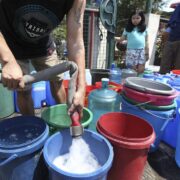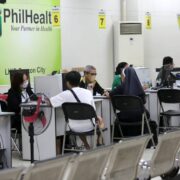In Albay, disaster is no hindrance to learning
LEGAZPI CITY—While trying to make up for lost time due to the COVID-19 pandemic, grade school teacher Jinky Mabini had to make sure that the suspension of classes would not stop her students from learning.
“We are still catching up with the numeracy and literacy skills of our students, so once there’s a suspension of classes, we are instructed to make sure that learning will still continue,” said Mabini, a teacher at Mi-isi Elementary School in Barangay Mi-isi, located within the 8-kilometer radius of Mayon Volcano in Daraga town, Albay province.
When some residents in the village were evacuated to another village in June after the volcano warning was raised to alert level 3, local schools started shifting to modular learning.
Teachers had to schedule the distribution of printed modules to students whose families had sought shelter in two separate sites in Barangay Anislag and to those who stayed at a relocation site in Barangay Salvacion.
“Even before the eruption, we’re already prepared because we have a stock of printed modules and we have soft copies, which we can distribute anytime,” Mabini said in a recent phone interview.
She said parents were also instructed on how to guide their children using the weekly home learning plan.
During the opening of classes for another school year in August, teachers conducted in-person classes in tents and open spaces, despite the inconvenience of being exposed to heat and rain.
Best practices
The COVID-19 pandemic prompted the Department of Education (DepEd) to turn to innovative ways to continue holding classes even without in-person interaction between students and their teachers.
Alvin Cuz, the disaster risk reduction and management (DRRM) coordinator of the DepEd Albay division, said the adoption of distance learning through modules was one of the best practices that they would continue using during class interruptions caused by typhoons, earthquakes and volcanic eruptions.
Cuz said the agency and every school in the province followed a contingency plan where classes would automatically shift to modular learning once in-person classes are suspended. He said the practice was later applied during the Mayon Volcano response.
“This is one of the best practices we implemented when many students were affected during the Mayon unrest. The teachers were trained to prepare the learning materials, and every suspension of classes, the modules are readily available,” Cuz said.But without the cooperation of the parents and the village officials, modular learning would not be effective, especially in remote villages.
Delivery by cart
Nonito Alemania, village chief of Mi-isi, said they were willing to restore the cart they used during the pandemic for the distribution of modules to the students during calamities.
Alemania said they would resort to house-to-house distribution of modules using the cart, which was later turned over to Mi-isi Elementary School.Their barangay hall also served as the drop-off point for the learning materials being collected and delivered by parents once accomplished by their children.
“The head of the committee on education helps in the distribution of the module, or sometimes they contact the parents so they can get their children’s learning materials at the hall,” Alemania said.
With the use of online chat groups or text messages, Ginalyn Maravillas, a Grade 2 teacher at Tumpa Elementary School in Barangay Tumpa in Camalig town, could contact the parents to guide her students in reading and answering the learning materials during class suspensions.
Maravillas said the learning materials used during the pandemic underwent quality assurance and were suited for the skill set needed by the students.
“Somehow, the modules crafted during the pandemic helped us, unlike before, we do not use modules during class suspensions. Even if it’s not perfect learning, at least students can get something from it,” Maravillas said.She said the school assured parents that there would be no learning gap again as they were still recovering from the impact of the pandemic and the almost four months of displacement of their students due to the volcanic eruption.
Maravillas said in-person classes held in proper classrooms resumed in early October after the families living inside Mayon’s danger zone and who were staying in evacuation centers, mostly schools, were allowed to go home.
“After the pandemic and displacement of people due to volcanic eruptions, the implementation of modular learning is really important to avoid gaps. When we were having sessions in evacuation centers, we only discussed major subjects during half-day class schedules in tents,” Maravillas added.
‘Default’ option
Under the Children’s Emergency Relief and Protection Act (Republic Act No. 10821), classrooms should only be used as a last resort for evacuation during calamities, but in Albay, Cuz said, schools became the “default” option because of the limited number of buildings owned by local government units (LGUs) that would house displaced families.
It states that schools can only be used as evacuation centers for 15 days at the most.
“The LGUs should find ways to construct additional evacuation centers to avoid the disruption of classes. The volcanic eruption might not directly affect the school facilities, but learning is directly affected, imagine we’re still reeling from the effects of the pandemic,” Cuz said.According to Cuz, school officials are trained in camp management and coordination so they can manage learning while schools are used as evacuation centers.
“Aside from contingency plans, the schools also implement a learning contingency plan, which ensures that the delivery of basic education is continuous,” Cuz added.
Rommel Negrete, head of the municipal DRRM Office of Camalig, said that with the limited number of buildings to host evacuees, they entered into a memorandum of agreement with DepEd to use the safe schools as temporary shelters during calamities.
“The LGU is in charge of paying the bills for the electricity and water, and we are assisting the DepEd in the establishment of temporary learning spaces for the displaced or affected students,” Negrete said.
While the families are inside evacuation centers, the local government will also be in charge of the repair of school facilities that may be damaged during their stay. INQ

















